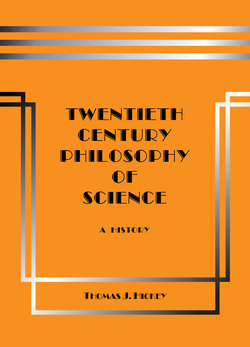Читать книгу Twentieth-Century Philosophy of Science: A History (Third Edition) - Thomas J. Hickey - Страница 86
На сайте Литреса книга снята с продажи.
4.06 Contemporary Pragmatist Aim
ОглавлениеThe successful outcome of basic-science research is explanations made by developing theories that satisfy empirical tests, and that are thereby made scientific laws that function in scientific explanations.
The principles of contemporary pragmatism including its philosophy of language evolved through the twentieth century beginning with the autobiographical writings of Werner Heisenberg, one of the central participants in the historic development of quantum theory. This philosophy is summarized in Section 2.03 above in three central theses: relativized semantics, empirical underdetermination and ontological relativity, which are not repeated here. Readers wishing to know more about the philosophy of Heisenberg are referred to BOOK IV below.
The institutionally regulated activities of research scientists may be described succinctly in the pragmatist statement of the aim of science. The contemporary research scientist seeking success in his research may consciously employ the aim as what some social scientists call a “rationality postulate”. The institutionalized aim of science can be re-expressed as such a pragmatist rationality postulate:
The institutionalized aim of science is to construct explanations by developing theories that satisfy empirical tests, and thereby make scientific laws that function in scientific explanations.
Pragmatically, however, rationality is not some incorrigible principle or intuitive preconception. The contemporary pragmatist statement of the aim of science is a postulate in the sense of an empirical hypothesis about what has been responsible for the historical advancement of basic research science. Therefore it is destined to be revised at some unforeseeable future time, when due to some future developmental episode in basic science, research practices are revised in some fundamental way. Then some conventional practices deemed rational today might be dismissed as misconceptions, and perhaps superstitions, as are the romantic and positivist beliefs today. The aim of science is more elaborately explained in terms of the other three functional topics as sequential steps in the development of explanations.
The institutionalized aim can also be expressed so as not to impute motives to the successful scientist, whose personal psychological motives may be quite idiosyncratic. Thus the contemporary pragmatist statement of the aim of science may instead be phrased in terms of a successful outcome instead of a conscious aim imputed to scientists. The successful outcome of basic-science research is an explanation produced by developing theories that satisfy critically empirical tests, and that are thereby made scientific laws that function in scientific explanations.
The empirical criterion is the only criterion acknowledged by the contemporary pragmatist, because it is the only criterion that accounts for the advancement of science. Historically there have been other criteria, but whenever there has been a conflict, eventually it is demonstrably superior empirical adequacy that has enabled a new theory to prevail. This is true even if the theory’s ascendancy has taken many years or decades, or even if it has had to be rediscovered, such as the heliocentric theory of the ancient Greek astronomer Aristarchus of Samos.
